

|
Home Updates Hydros Cars Engines Contacts Links Contact On The Wire |
Tight Lines
What do you do with it all?
We have often commented in various Pylons over the trials and tribulations of selling off collections (and hoards), and now we see that it has been raised as a thread on the Barton Forum. It is a problem that is never going to go away so we have put together some of the options and attendant pitfalls that can arise. We are often asked to advise in such situations and there is no clear cut answer as so much depends on the individual situation, yet over the life of OTW we have been aware of, and even involved in the disposal of at least 12 major collections, of which four could legitimately be described as 'eclectic hoards of stuff'.
A word of caution though, tax rules and inheritance rules are very different across the world, so we can only be specific about the UK, but even here the goal posts have changed significantly in the last year and are due to the election here have changed again, and not to the benefit of those involved either.
There are two clear situations where collections are to be disposed of, firstly when the owner wants (has) to downsize, rationalize or raise some cash. The one advantage is that they usually have time on their side so can pursue whatever avenue will produce the best results for them. The more complex is where the avid acquirer has passed on and a family member or members find themselves the owners of a huge collection of assorted 'stuff', or an unconnected executor is tasked with sorting and disposing of it all. Even worse is as has happened recently on a couple of occasions where an unsuspecting distant relative is lumbered with it all as the person in question died intestate.
First of all the situations that can arise. A spouse becomes the legal owner of everything, no problem, it is theirs, and no immediate pressure, unless they want to raise money or 'get rid' in which case there is no tax liability until they come to dispose of it, as there are clear rules as to what can be sold from an estate without incurring charges but this does not include collections. In every case, the assortment of 'stuff' would have to be included in the estate for probate, giving it a finite value, probably way below its real value increasing the CGT liability?
A single legatee is in exactly the same position, again the relative luxury of no time constraints as they are now the owners. Where it gets very complicated is when the estate has to be divided between more than one person, by either a legatee as an executor or an unconnected third party executor. Human nature can be very fickle when family inheritances are involved, and most want as much as they can get as soon as possible.
So, what are the options? Well, one suggestion on the forum was that the collector has told his children to put everything in the recycling bin. This they may well do, unless they become aware of the potential value of what they are scrapping? We have mentioned before the mother and daughter who put an entire collection of several hundred engines in the bin so that the daughter could have the fitted cases. Would they have still done it if they knew what they had potentially been throwing away? We have met two large scale hoarders who have told their children that it is all theirs to do with as they like, but as none of them have any interest at all in engines, it was suspected that they might well end up in the skip? Again, if its yours, you can do what you like with it, but if two or more people involved then there might be objections to this route. After all, even a modest collection now can be worth in excess of £50,000 and who keeps receipts or is even totally honest about how much they paid?
From there on it becomes a numbers game, just how big and varied is the collection or hoard? The problem multiplies rapidly as the numbers, variety (and potential value) goes up. There has to be a note of caution as well as what follows does depend on the honesty and integrity of those involved, which sadly, has not proved to be the case on occasions.
If the new owner who has inherited goodness knows what that they have no interest in, they might just want rid, and the simplest answer is to contact existing dealers or individual and ask them to make a bid on taking everything, ie. no honey deals. The downside is that they might be offered as little as 10% of the value or even less, especially if they are totally unaware of the possible value. The dealer then has to do all the work, will probably make a hefty profit but over an indeterminate time scale, but the house and workshop are clear and there is a wodge of money. We have brokered deals of this sort and are aware of many more, sadly, at least three that we had no part in at all involved the widow being royally 'stitched up', hence our warning about honesty.
It then comes down to how much you want to be bothered, how much time you are prepared to spend, and whether your knowledge is up to the task? The simplest solution is an auction, only suitable for a finite number of items though and they will not get rid of the assorted and unidentifiable spares and bits. Bear in mind how much of the late Miquel de Rancougne's collection was consigned to a second and lower profile sale and the items that the auction house binned? This is further complicated now by the shortage of specialist auctions and valuers, and in some cases, their insistence on a minimum value for each lot. There is also the small matter of lotting fees and seller's premium, but it does mean that they are responsible for the identification, photography, description and the entire selling process. You just sit back and get a cheque at some stage. Relatively few options now, although the BMFA does provide a good outlet at minimal cost, but they are restricted in the number of items they can process in just two auctions a year.
Otherwise, it is down to doing it yourself, if you are the main beneficiary, or enlisting the help of a knowledgeable friend, but it is unrealistic to expect them to do the work for nothing. Ebay is the most obvious route as it gives you the widest audience and will realise the best prices, but everything is down to you including the comeback if the buyer is not happy. You can of course enlist an 'ebay friend' but these don't come cheap, up to 40% of the sale. There is now a further and serious complication in the UK in that ebay, etsy and all other auction platforms have to pass sales records to the tax man as this is now regarded as 'side hustling' and rendering you liable to income tax after sales over £1800, about four good engines (or two yellow jackets) in a year. There is also the side issue of not flooding the market, say ten engines a fortnight max so a two or more year process in prospect that other legatees might not be happy with, although this will also render the seller liable to tax on the whole amount and possibly even Capital Gains Tax on top. One of our correspondents has suggested that it could take up to five years to clear what has been inherited, and that is with two of them working steadily on it via ebay and swapmeets.
The final options all involve producing a detailed list with all items identified, condition and any defects clearly noted. One Swedish seller actually produced a full colour A4 folder with every car and engine for sale, two photos of each and prices, an enormous amount of work. Once the list is complete then there is a choice, to price, or not to price, depending on the next step. Over the years we have become aware of two interesting variations, the 'silent auction' where the list is circulated, either widely or to a restricted group who are then asked to bid, the highest bidder wins, unless the seller did not consider the bid high enough or derisory as was the case with another Swedish collection. An extension of this is the concept of the 'Nazareth style auction' where the highest bidder does not win, as all other bidders are given the chance to improve their bids, which can go on for ages, time consuming and hardly appropriate if you are trying to shift 500 motors.
We are firmly of the opinion that items should be priced, which brings us to the route we favour and that has been used by a number of sellers in the last few years. Price every item, circulate the lists, used to have to be done by post but can now be online, wait to see what sells and update lists regularly. Of course, prices do have to be realistic, especially if you are looking to clear as much as possible. Like the auctions, this will leave you with a lot that there is a very limited market for, bits and pieces and the assorted detritus that can be acquired over a lifetime of collecting (hoarding). Then it is down to the swapmeet or sadly, the skip.
Swapmeets are not great for disposing of collections in one go, turning up with 1500 or even 500 engines will not endear you to other traders and neither are there enough punters to make a dent in that number, and that applies at auctions as well. A table full of odds and ends, priced to sell will clear what can be, but after a couple of goes, the skip is the only other option. When engines that are being offered for free are still in the box at the end of the day, that is a clue as to their desirability.
Ultimately, unless you are prepared to identify, describe and photograph anything up to 4,000 engines or more, deal with the sale, pack and post said number and deal with post sale problems, then the options open are very limited. Also it very much depends on the personal relationship with the engines, and ultimately who gets the cash, especially if you are a non benefiting executor or acting on behalf of more than one legatee when it can get very messy.
What does help immensely is a bit of forethought where what can be put together is, correct engines in boats and cars and everything labelled. If it is yours, then you will probably know exactly what it is and the history behind it, but if it 'aint written down then its guesswork or worse for whoever is sorting it, which can affect values considerably.
It is a sad fact that at present the quantity of items awaiting disposal is absolutely staggering, especially as some of the very largest collections are already on the market via various means or will be so in the very near future. Difficult to believe but OTW is aware of over 15,000 engines alone that will have to be sold or otherwise disposed of.
Tight Lines Special. Tyres The vital component.
We have been approached by a regular contributor and runner at Buckminster who has become concerned with the number of tyre failures that have been experienced recently, both on and off the track. Unfortunately, this is all too common, right from the fastest FEMA car through to the most pedestrian of retro cars.
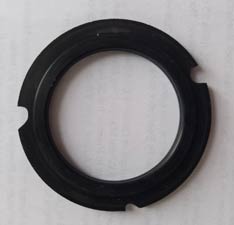 |
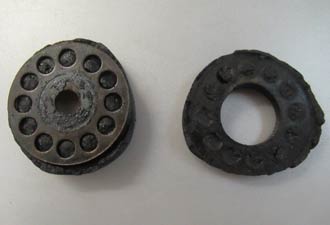 |
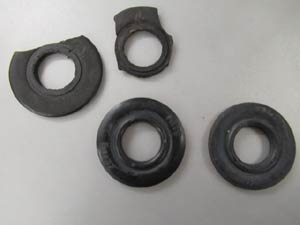 |
| Unusual FEMA failure | Raylite style that failed | Solid tyre failures |
There are essentially four styles of tyre that are in current use. The flat and very thin, vulcanised rubber FEMA style tyres, moulded solid rubber, moulded hollow rubber and rubber bonded on to a steel core, Raylite style, also used commonly in the eastern bloc and for much larger wheels. What each of the first two relies on totally is a bead or groove that matches the wheel halves to keep it on the wheel, very much like a full sized car tyre that relies on air pressure. In the case of the hollow tyres either a perforated ring was inserted into the tyre to stop the bead coming out or the tyre was designed so that when the wheel halves were tightened up the two beads of the tyre were clamped together so securing the tyre within the bead groove.
Similarly with the solid tyre, but many of those being produced or used by British companies in the late 1940s did not have any bead at all and just relied on the integrity of the rubber on a hub to keep the tyre in place. Often a tyre would have to be stretched over a rim to get it to seat, not an easy job and one would assume that the tyre was there for keeps? Usually the tyres were solid enough to maintain their shape at the speeds of the day, but as speeds increased, there was absolutely nothing to stop the tyre expanding and either cracking or coming off the hub completely as contemporary photos show, with complete tyres or longs strips of rubber exiting the circle.
|
The Raylite style however depends entirely on the bond between the rubber and the steel washer and that the rubber has flowed through holes in the washer to create a single, solid tyre. In the US balloon tyres were made to expand as revs increased so increasing the effective gear ratio. In the UK Greenhalgh developed this further with the 'Grenwyn flinging tyre', which grew alarmingly at speed. In both cases a bomb proof bead and groove are required to keep the tyre in place.
What is not perhaps
appreciated is that the wheels on direct drive cars
and those on geared cars can be rotating at broadly
similar revs. The vital difference is in the
diameter of the tyre that make the peripheral speed
and centrifugal loading vary immensely between 80mph
and 200mph, it's all down to the V squared part of
the sum. |
|
A tyre intended for a FEMA car is going to be more than adequate for any car likely to run at Buckminster, but there is a limit to the minimum size available and matching wheels are required, a solution that is being used regularly here, Australia and the USA
The alternative is to use existing vintage tyres, but these can be of very varying quality. Of the thousands of tyres made for ZN and 1066 some are rock hard and would probably break or disintegrate, some are perished beyond salvation, but others are seemingly soft enough to run safely up to sensible speeds, especially on non driving wheels.
For a while there was a growing market in reproduction tyres of many sizes and configuration from small Raylites up to the largest balloon tyre for 10cc cars. The late Ron Bernhardt in particular produced a range of ten tyres that were fine to run but no longer available. Endre Bogden also moulded a huge range of different tyres, but with the advantage that the name or logo of the original manufacture was included in the moulds.
|
|
|
|
| Rock hard McCoy and C&R | Dooling & Rowell with ring | Solid moulded with metal core |
Endre sold up his entire
stock in 2018, but has now passed the moulds on and so new tyres are already becoming
available, particularly Raylites with the correct lettering.
Similarly, Arne Zetterstrom had dozens of tyre moulds, that
we, collectively, tried to acquire after his death, but they
have now disappeared.
|
|
There were a huge range of reproduction tyres being manufactured in the US, but there was a clear warning that these were 'for display only' and not to be run, and herein lies the problem. There are two stages to moulding tyres as Steve Turley gave us chapter and verse on, the composition of the rubber and the vulcanisation process. Both have to be right to avoid failure, and unfortunately, recent attempts to reproduce tyres, not in the UK we add, have led to substandard tyres, liable to burst at speed. Using thermoplastic material is a quick route to disaster, which was what occurred in the US. Even more problematical was an entire production run of reproduction tyres and wheels that had been designed with no bead or bead groove in the wheel, so that at any realistic speed, the tyre just pulled out of the wheel 200 wheels and 400 tyres again for display only. Left: Reproduction ZN tyre and wheel with no bead or groove, tyre expands off the wheel at modest speed. |
|
What is happening is that the rubber expands, but not equally, so that the tyre goes oval creating huge vibration and pulling out of the bead. If this happens when the car is not under load then the tyre will explode sending shrapnel everywhere and probably causing injury. The tyre failures we are experiencing in the UK are down to using tyres past their sell by date, allowing engines to run up with no load and failures due to fault in the manufacturing. Most worrying have been the failures of seemingly perfect and new twinshaft tyres where there was no bond between the steel washer and the rubber or any signs that the rubber had flowed through the drilled holes. Jan Huning has experienced this on more than one occasion and when it happened again at Buckminster it was possible to peel the rubber away from the washer completely. The entire washer was removed from the tyre with no sign of it having been bonded anywhere. |
|
Here it is important to point out that these do NOT include the new production of Raylites being supplied by Oliver Monk.
The current situation
regarding tyres that can be run safely is not wonderful.
There are new production Raylites available in one size only
and a selection of Raylite and 1066 'style' available in the
UK from Bill Bannister. Pavel Sarigins can supply fronts and rears in limited
sizes. Mike Francies and Nigel Bathe have been making tyres
for their own use for a while, but are hoping to make these
available, with wheels, when the final spec has been arrived
at. FEMA tyres are available from Michael Schmutz, but as
yet he has not got his sales site up and running, so apart
from that it is what can be sourced from existing stocks
held by enthusiasts or from collectors that might not
require all they have.
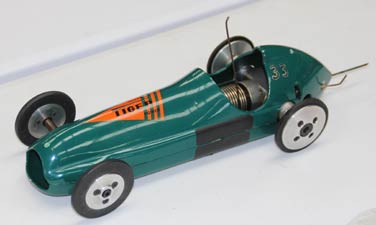 |
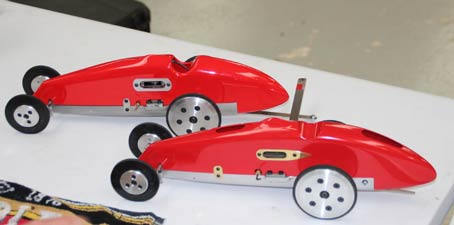 |
| Oliver fitted with beaded tyres | Moore #11s with FEMA wheels and tyres |
|
We recently unearthed around 130 pairs of reproduction tyres, but all of them were by then twenty years old. Some were eminently useable, others with caution and inspection and a large number that were either so hard, so soft or incorrect design that they again were suitable for display only. It may seem difficult to believe, but at any international meeting, dozens of tyres are thrown away or freely available as the have been cut to a specific size and then discarded when worn, perfect for our use. Why some tyres can last seventy years and be fine is something of a mystery, but compare with the tyre on the right that now has the consistency of toffee fudge yet is fitted on a SMRU car being used until very recently. |
|
In the early days of
running tethered cars in this country there were no tyres
available, so it was often rubber rings glued to wooden
wheels, heel rubber, conveyor belt or railway rubber clamped
between wheel halves.
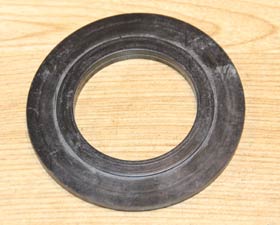 |
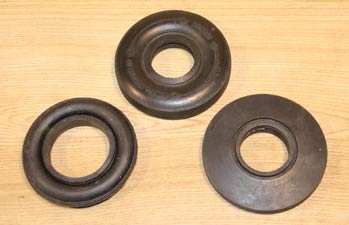 |
 |
| FEMA 10cc tyre | 1066 and ZN repro, Grenwyn | Repro Moki and small FEMA |
|
Some may remember the lovely ETA powered car that appeared on Find It fix it Flog it with Henry Cole. The tyres had perished, but they declined our help and advice so they had dummy wheels made up with rubber strip glued round the outside, you can imagine how long they lasted? This is not the only tale of woe as a newly built car recently came on to the market where the tyres were again just rings of rubber, albeit with a tread pattern, but just rolled on to a plain wheel, and on a car with a potential in the high 80s, imminent disaster? This is another example of how a shortage of useable parts can hold back progress, but those we do have might not be safe to use. Seventy years ago, Jim Cruickshank built a tyre testing rig just to see what did happen to the tyres he had available at the speeds he was anticipating, and that was for running at very modest speeds. Note that Jim is well removed from any danger. |
|
2nd International Model Engine Swap Meet 15th February 2025
L.W Compressors ~
Lampertheim-Huttenfeld ~
Germany.
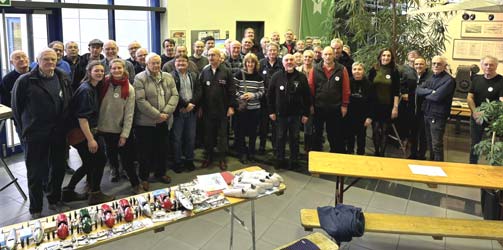
British enthusiasts were invited to attend the second year of running this model engine swap meet just south of Frankfurt in Germany. I had been to three similar events some years ago in Germany and one in Switzerland and had the urge for more. I and two friends decided we would like to attend and we would display Oliver model tether cars, castings plus a few engines between us. The good friends were Ian Harper and Martyn Serginson. Unfortunately at the last minute Martyn could not join us.
Ian and I met at Birmingham International Airport early on 14th of February and flew with Lufthansa to Frankfurt the busiest airport in Germany and it is massive airport too. We picked up a Hire car there, a Passat Estate that had been booked, but a Golf estate was all that was available. A refund was refused by “Alamo”? Satnav was also an extra they wanted to charge for, but Ian had got this on his mobile and linked it to a tablet, so not required. So please take note, it might look cheap to start with, but?? We arrived at Hotel Felix at Bensheim in good time about fifty minutes later and after booking in to our rooms, drove to the venue LW Compressors at Lampertheim-Huttenfeld about 10km and twenty minutes distant.
|
We were met and welcomed by event host and organiser Amadeus Kurz and shown our table. His friend and co-organiser Dr. Peter Rathke was also on hand to welcome us, a very knowledgeable man on engine history. I have known Amadeus for many years over engine deals, but we had not met previously. The Oliver cars, ten in all, were unwrapped from their protective bubble wrap and set out for display along with a few Oliver body castings, all that we could carry between us. I also took three engines to sell and a few German Taifun and Webra engine spares most of which did sell on the Saturday, plus an engine for my son Paul. I limited the engine numbers in case of customs problems on return as we are no longer in the EU since my last visits, as it happened I need not have worried. I printed “duplicate lists” of my cars just in case, which I had counter signed by the organiser Amadeus, as proof of what I had taken and would be bringing back. Back at the Felix Hotel the evening dinner was to be stall holders and a few friends about thirty in all and I recognised a good few faces, but names did not come readily to mind? We met Lyndon Bedford son of Ken Bedford the ETA designer and manufacturer propping up the bar, he was a specially invited guest and he joined us for the meal with the other stall holders. He travelled by train from the airport, so we agreed to give him a lift to the venue. Weiner Schnitzel consumed, a beer plus a bottle of red between us we retired zonked out. |
|
|
|
The next morning after continental breakfast at 21 euros each the three of us set off for LW Compressors and completed the stall set up after arriving at 08.00 hrs. It was a very good day with lots of homemade multi cylinder and radial engines on display and many more engines for sale or trade. LW housed the event in quite a large glass fronted building used a as a museum for deep sea diving equipment which their compressors are made for. Examples of diving kit from early days to the latest adorned the premises plus a collection of Nikon camera equipment and a host of racing motorcycles, another attraction for me. |
Two of the bikes MV Augusta’s owned by Herr Wagner one of the company partners, as raced by Giacomo Agostini were run twice during the day, what a sound. I was at Mallory Park when John Cooper beat Ago on the MV riding a BSA triple.
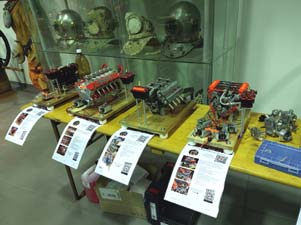 |
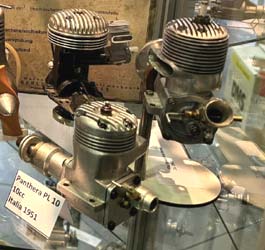 |
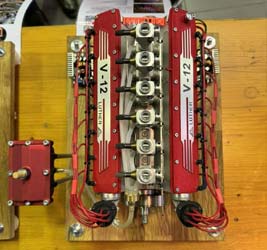 |
| Exotic multis | Penna 10cc and Lancia 10cc | V12 run outside, sounded amazing |
The other outdoor attractions were the running of several multi cylinder model engines, single cylinder, twins, Vee eights to radial cylinders and a couple of RC Nitro cars showing speed and manoeuvrability on grass and tarmac. A portable, miniature tether car track about 2m diameter at most made by Thomas and Manu Finn from Germany was operated, on which tiny IC engine cars were run with I think Cox TD 010’s power, which went unbelievably well. These must have had on board glow as once they were warmed up, were pushed off smartly by hand with no pull out battery power?? There was also a good contingency of Tether car enthusiasts which included multiple World and European Champion Horst Denneler European Champion Michael Schmutz, Phillip Meier and the father of all tether car champions, Paul Otto Strobel. Their tether car display showed record breaking cars and lots of spares with continuously running videos of some of their cars breaking European records.
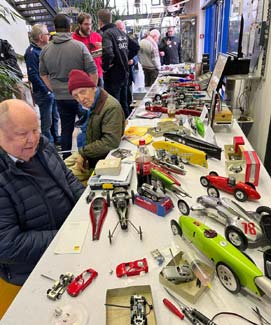 |
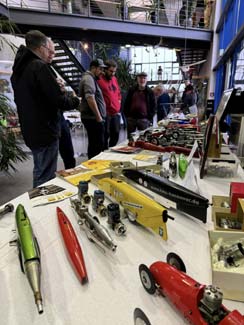 |
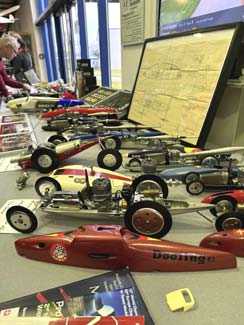 |
| Horst Denneler & Paul Otto Strobel | Philipp Meier explains | End of era 10cc side exhaust |
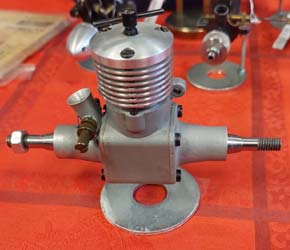 |
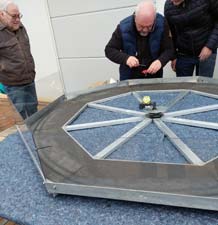 |
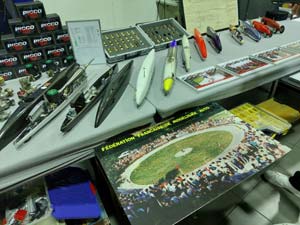 |
| Rekord twinshaft | Thomas Finn with car track | Tethered car collection |
Amongst the line up of
tethered cars on display were the late Mats
Bohlin's 2005 Championship winning car, all white, and with
the yellow nose, the car that finished second in both 2009 and 2010,
beaten on each occasion by Mats with his other car, an amazing
achievement. The all black car is a carbon composite model built by
Michael Schmutz.
The event is predominantly organised for engine collectors and the Guild of model engine builders of Germany and the engines our continental friends collect are vastly different to what most in the UK collect. We tend to go for commercially made engines and prototypes, whereas in Germany multi cylinder rarities are sought after avidly and command high prices in turn. Some of the European builders make one off multi cylinder engines, often starting with a base engine and adding more cylinders to produce a range of similar, but more and more complicated engines, Vee 6, Vee 12 in line 4 to 8 cylinder and radials. Most of them seem to be CNC machined from bar stock rather than castings which engine builders in the UK tend towards, but not exclusively. These are usually free lance designs and some scale types, but all without exception showing great skill and dedication in producing exquisite model engines and they take great pride in running them as well.
|
One of the faces I recognised at dinner the night before was Luis Peterssen who had worked with Paul Bugl, and after he died prematurely, with compatriot Jens Geschwentner who with his brothers and other’s produced the later Bugl developments of Team Race diesels in Holland, the BG (Bugl-Geschwentner) series. Both Luis and Jens had tables selling mostly engines and Jens a couple of tether cars one an Oliver Tiger 2.5 car. Among those displaying and selling engines was Lyndon Bedford with the family ETA collection, Salvatore Angeloni from Italy mostly Super Tigre, Gabor Dobrocsi from Hungary displaying Rekord and Moki engines. Two young sisters were selling their late fathers vast collection with some reasonably priced engines from a wide range of makers. One of them had done a degree course at Sheffield University and spoke very good English as did most of those there. Right: Bugls and Bugl spares |
|
On the adjacent stall to us were two friends from Austria who worked together and were developing a twin cylinder 1924 scale Daimler aero engine replica using 3D printing techniques initially in plastic to prove fits and assembly and finally in metal. The results looked very impressive. Is this the future? It is clear that the event brings together engine collectors, engine builders, model flyers of all disciplines and tether model car enthusiasts ancient and modern from all parts of Europe with entrants from France, Hungary, Italy, Austria, Switzerland, Czech Republic, the UK and of course many from Germany among those I met. Probably the most important benefit of attending this event for me is this coming together of like minds, cultures and diverse interests for the common good and understanding, we all learn from each other.
I bought a Hungarian 1958 Rekord twin shaft tether car engine off them in near new if not new condition with stonking compression for 180 euro. The Rekord was the forerunner of the famous Moki engines, so Gabor informed me. My friend Ian Harper was very keen on an Offenhauser four cylinder scale engine on another stall, but the 5000 euro price tag held him back, so far anyway. Watch this space?
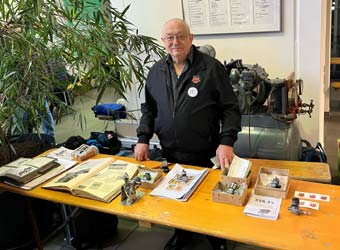 |
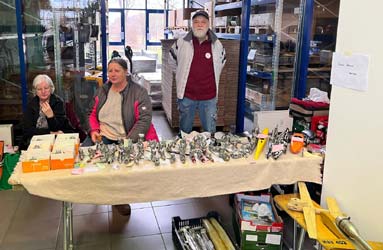 |
| Lyndon Bedford with a table of ETA memorabilia | Gyorgi Bondor and Gabor Dobrocsi from Hungary |
Two demonstrators in the hall used compressed air power to run a very nice horizontal single and others multis giving occasional bursts of quiet power and no pollution. Organiser Amadeus Kurz had a very nice display of very rare engines, some tether cars and a few CL speed models in three glass fronted tall cubicles and also had tables with many engines, spares and models for sale. Several Racing Yamaha two stroke motorcycles adorned one of the balcony’s surrounding the hall’s upper level with many examples of diving kit, suits and compressors filling all corners and spaces of LG Compressor’s company memorabilia collection, all adding to the charisma and ambiance of this thoroughly enjoyable occasion.
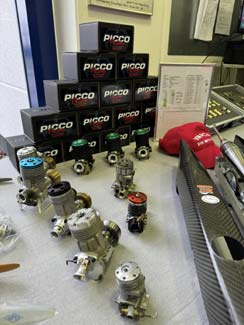 |
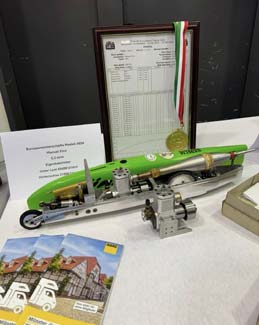 |
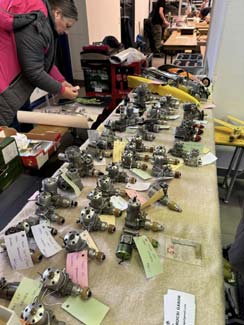 |
| Old and new Piccos | Manu Finn's record breaking 2.5cc | Engines from Gabor |
The event was concluded with another dinner at Hotel Felix where about thirty of us enjoyed a meal with drinks, much banter and discussion on our various modelling interests and happenings of the day and the past. Three of the past Swiss tether car European Champions were present, Paul Otto Strobel, Michael Schmutz current President of FEMA the governing body and Philipp Meier expressed their hope to visit our tether car track at Buckminster Lodge this coming summer, possibly in June, they believe their own national bodies should have facilities like Buckminster, I agree. You need to be there.
 |
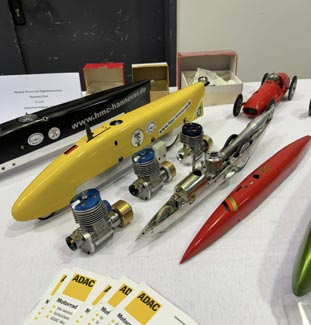 |
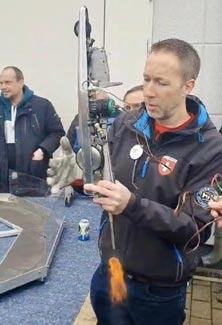 |
| Thomas Finn's 5cc, home built motor | Class 2, 3 & 5 with record holding Movosprint | 'Wet start' with a 10cc Picco |
The greatest enjoyment and privilege of the event was meeting, mixing and talking to these illustrious people and to find that their thinking is very much in line our own thoughts for the future of our hobbies and activities. That is it is up to every individual, club and national authority to do whatever is possible to promote these interests and encourage more people, particularly younger people to join our activities, unless we do we risk oblivion.
 |
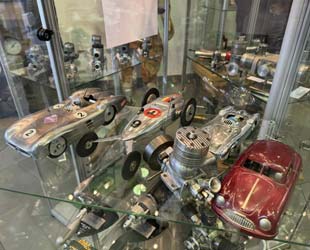 |
| Not Lucy Gascoigne's car but a super, modern replica | Tethered cars and another mystery 10cc |
I believe having now visited Germany again, a similar event at Buckminster Lodge with its far superior facilities, but to include all model disciplines, planes, boats, cars and model engineering all flown and or running, a racing motorcycles paddock with engine running also taking part. I believe the cross fertilisation would be a valuable tool. We could eventually even add Microlights, hang gliders and sailplanes to add diversity and further interest to the aviation base? It could be a much superior International event and would attract enthusiasts and participants not just from Europe, but worldwide and additionally do the BMFA coffers a much needed boost and good publicity. Stay still and we will stagnate and die, we have to move forward continuously to survive!! We have enough people amongst us who have the necessary contacts, Ian is a microlight pilot and part owner of a C42 and I have done some hang gliding and other light aviation and a lot of motorcycling. All it needs is an organiser with the needed drive and commitment. Any takers, the entire model movement desperately needs you to come forward? In case you are wondering at 86, I sincerely feel it needs someone younger than me.
Thanks to John Goodall for this comprehensive report. Thanks also to John, Michael Schmutz and Christoph Zaugg for photos and whatsapp for the 150+ images transferred at no cost. For videos of engines, bikes and tethered cars running search out Michael Schmutz's facebook page. Michael has also published an extensive report from the event on the speedmodelcar website.
©copyrightOTW202
5